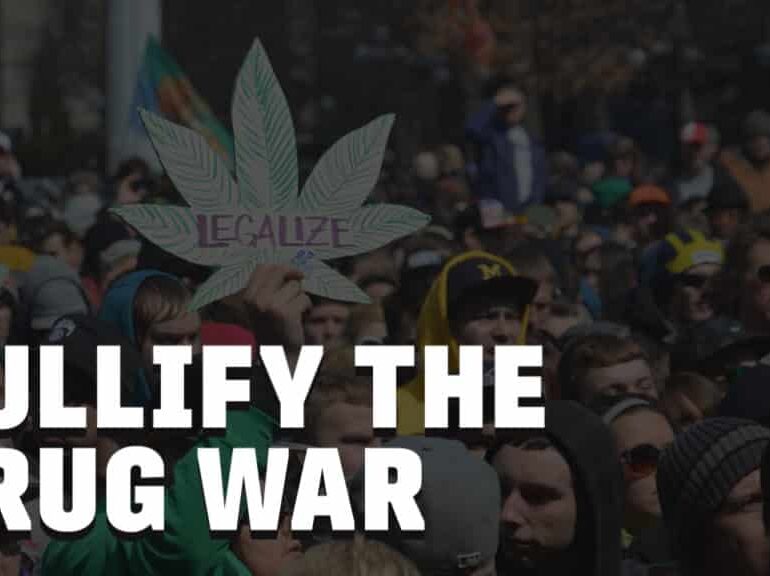
The Nullification Movement Pushes Foward: More States Legalize Marijuana Despite Ongoing Federal Cannabis Prohibition
By: Mike Maharrey
Voters in two more states approved ballot measures legalizing marijuana on Tuesday despite the ongoing federal prohibition of cannabis, continuing a 50-year history of efforts by the states to nullify the feds, cities to nullify the states – and individuals to nullify them all.
Maryland and Missouri both passed ballot measures legalizing marijuana for individuals 21 and over. That brings the total number of states that have legalized recreational marijuana to 21.
The movement to take down marijuana prohibition started in the 1970s accelerated after California legalized cannabis for medical use in 1996. Since then, states have advanced the issue every year. This happened in spite of a 2005 Supreme Court opinion supporting federal prohibition, at least 12 years of relentless year-to-year increase in spending and enforcement efforts by the federal government through three presidential administrations, and ongoing, complete prohibition at the federal level.
In California, individual and local action started long before the passage of Prop. 215 legalizing medical marijuana in 1996. Other states followed their lead. Many states started with modest medical programs and then expanded them over the years.
We’ve seen the same progression when it comes to adult-use marijuana.
Each year, new state laws and the loosening of old laws help expand the market, and each expansion further nullifies the unconstitutional federal ban in practice and effect. With state and local actions accounting for as much as 99 percent of all enforcement efforts according to the FBI, the feds rely heavily on state and local help to fight the “drug war.” That help has rapidly evaporated in the last few years with marijuana legalization and decriminalization.
As more states, localities, and individuals simply ignore the federal prohibition, the feds become less able to enforce their unconstitutional laws. After more than two decades of state, local and individual resistance and nullification, the federal government’s unconstitutional prohibition of cannabis is beginning to come apart at the seams.
MARYLAND
Maryland voters passed Question 4 by a 65-35 percent vote. The state constitutional amendment legalizes the use of cannabis by an individual who is at least 21 years of age on or after July 1st, 2023. The amendment also authorizes the Maryland General Assembly to “provide for the use, distribution, possession, regulation, and taxation of cannabis within the state.”
Earlier this year, Gov. Larry Hogan allowed a bill to become law without his signature that creates that regulatory structure. With the passage of Question 4, that bill goes into effect. Under the law, adults 21 and over can legally purchase and possess of up to 1.5 ounces of cannabis. It also repeals criminal penalties for the possession of up to 2.5 ounces. Adults can grow up to two marijuana plants for personal use. The law includes provisions to automatically expunge past convictions.
MISSOURI
Missouri voters approved Amendment 3 by a 53-47 percent vote. Under the constitutional amendment, adults 21 and over can legally possess up to three ounces of marijuana. It also creates a licensing and regulatory scheme for retail sales. Individuals can grow up to six flowering plants, six immature plants and six clones. The measure also includes provisions to create a program that will automatically review and expunge criminal records relating to non-violent marijuana-related offenses.
EFFECT ON FEDERAL PROHIBITION
All of this is illegal according to the federal government.
Under the federal Controlled Substances Act (CSA) passed in 1970, the federal government maintains a complete prohibition of marijuana. Of course, the federal government lacks any constitutional authority to ban or regulate cannabis within the borders of a state, despite the opinion of the politically connected lawyers on the Supreme Court. If you doubt this, ask yourself why it took a constitutional amendment to institute federal alcohol prohibition.
The legalization of marijuana removes one big layer of laws prohibiting the possession and use of marijuana in a state even though federal prohibition remains in effect. This is significant because FBI statistics show that law enforcement makes approximately 99 of 100 marijuana arrests under state, not federal law. When states stop enforcing marijuana laws, they sweep away most of the basis for 99 percent of marijuana arrests.
Furthermore, figures indicate it would take 40 percent of the DEA’s yearly budget just to investigate and raid all of the dispensaries in Los Angeles – a single city in a single state. That doesn’t include the cost of prosecution. The lesson? The feds lack the resources to enforce marijuana prohibition without state assistance.
A GROWING MOVEMENT
Colorado, Washington state, Oregon and Alaska were the first states to legalize recreational cannabis, and California, Nevada, Maine and Massachusetts joined them after ballot initiatives in favor of legalization passed in November 2016. Michigan followed suit when voters legalized cannabis for general use in 2018. Vermont became the first state to legalize marijuana through a legislative act in 2018. Illinois followed suit in 2019. New Jersey, Montana and Arizona all legalized recreational marijuana through ballot measures in the 2020 election. In 2021, New York, New Mexico, Virginia and Connecticut legalized marijuana through legislative action, and Rhode Island legalized cannabis for adult use in 2022.
With 37 states allowing cannabis for medical use, and 21 now legalizing for adult recreational use, the feds find themselves in a position where their unconstitutional federal prohibition is falling apart at the seams.
The lesson here is pretty straightforward. As Tenth Amendment Center Executive Director Michael Boldin noted, “When enough people say, ‘No!’ to the federal government, and enough states pass laws backing those people up, there’s not much the feds can do to shove their so-called laws, regulations, or mandates down our throats.”